Advanced CMOS Detectors: Enabling the Future of Astronomical Observation
Watch our recent webinar
CMOS designs feature a combination of high QE, high dynamic range, short readout times and low noise making them a competitive alternative for a wide range of astronomy applications. If you would like to find out more about our future CMOS capabilities within astronomy, watch our on demand webinar Enabling the Next Generation of Astronomy.
Introduction
Ground based astronomy provides an accessible way to image objects in space. As most of the objects in space can be observed within the visible wavelength range (380-700 nm), optical astronomy has been at the forefront of astronomical observation. Many objects in space are very faint , requiring a camera with high sensitivity and minimal noise to detect their weak signal.
For decades, back-illuminated CCDs, with >95% quantum efficiency (QE) in the visible, have been the go-to detector choice for astronomical observation. The faint signal of objects within space often requires long exposure times to ensure detection. Figure 1 shows two images, one of the Pleiades and the other of the Milky Way taken by CCD cameras.
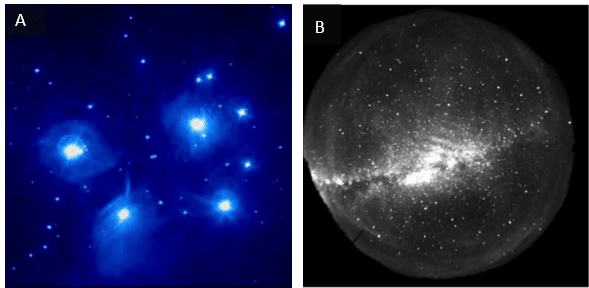
Figure 1: Images of A) the Pleiades and B) gravity waves and the Milky Way taken using a CCD camera.
Images courtesy of Rozhen National Astronomical Observatory and Korea Polar Research Group respectively.
The ability to detect this signal is constrained by various noise sources, and this limitation is typically defined by the signal to noise ratio , or SNR. Typically, the higher the SNR, the better the image. There are several noise sources , including shot noise from the source and background noise from the sky, which are inherent to ground based observation [1].
Two additional noise sources are native to the camera, read out noise and thermal noise. Read noise is essentially the " noise floor " of the image and is reduced by proper electronic design. Thermal noise, or dark current , is the noise generated from thermal sources and is directly correlated to temperature and exposure. Dark current increases with long exposures (minutes and longer) regardless of camera technology. To significantly reduce dark current, and improve SNR, back-illuminated CCDs are deeply cooled to reduce the amount of thermal noise contributing to the signal [2]. For these reasons, when very long exposures are needed to capture faint signals , CCD cameras have been the best option.
There are other applications in ground-based astronomy for which CCD's are not the best solution . One of these is the requirement to operate imaging sensors at faster time scales . Applications, such as time domain astronomy and space debris tracking, require faster times scales to capture as much information about dynamic objects or events .
Faster time scales are determined by the combination of exposure and readout speed . For CCD's photons are converted into photoelectrons , and during readout, the detected photoelectrons need to be shifted to one (or sometimes a few) readout nodes, causing a bottleneck that slows readout . Fast readout on CCDs requires very fast measurement of signals at these readout nodes, performed by analog-to-digital convertors (ADCs). This high-speed measurement reduces signal quality through introducing a high level of read noise [3]. Detectors with large sensor areas and high number of pixels (4k x 4k or greater) have long readout times where no signal can be acquired, ranging from seconds to tens of seconds even at higher ADC rates.
Full frame CCDs, typically used within astronomy, require mechanical shutters to completely block any incident light during readout [4]. Mechanical shutters have finite lifetimes and often need to be replaced frequently when the camera is in heavy use. This can be problematic for observatories in remote locations where maintenance can be challenging. Additionally, opening and closing a mechanical shutter is relatively slow , leading to slower frame rates and quantitative errors for shorter exposure times.
EMCCDs, an alternative sensor technology, are typically used for more challenging, dynamic observations . EMCCDs use on chip amplification to elevate the signal relative to the read noise. With this low or negligible effective read noise, EMCCDs can operate at much higher frame rates more suitable to capture the evolution of dynamic events while maintaining the required SNR. Figure 2 shows a schematic of EMCCD sensor architecture, showing how the on chip amplification elevates the signal above read noise.
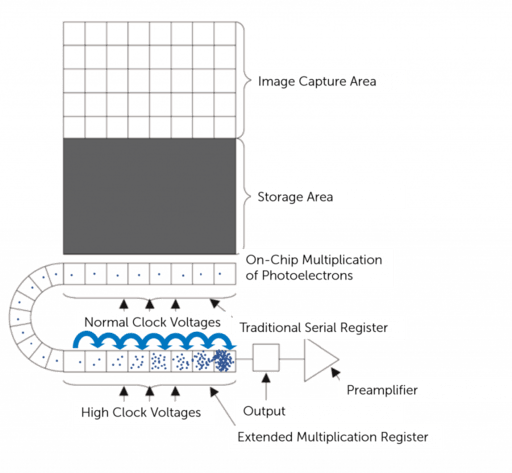
Figure 2: Schematic showing an EMCCD sensor. Photons are collected and converted into photoelectrons within the image
capture area which are then transferred to the storage area. These electrons are then amplified in the
extended multiplication register which increases the signal produced without increasing any read noise.
Many EMCCDs have a fast, electronic shutter where exposure is stopped by shifting detected photoelectrons into a frame storage area before readout. The electronic shutter is not only more precise than mechanical shutters, but also leads to lower dead time of the detector during which the camera is not exposing to light, as subsequent exposures can already start as signal is readout from the storage area. This is referred to as ' High duty cycle '.
Although EMCCDs can operate at higher frame rates , duty cycles and are ideal for the detection of ultra-weak signals , they are limited by excess noise . This additional noise source is caused by the random nature of the on-chip amplification process and causes a sacrifice in overall sensitivity for signals larger than a few photons per pixel. For more information on these limitations, please refer to our article Types of Camera Sensor [5].
The Advantages of Advanced CMOS Technology
Traditional CMOS sensors have not been widely considered for astronomical observation as they are front illuminated, typically having low QE and operating at higher read noise and poorer linearity (proportionality between detected signal and digital signal) compared to CCD and EMCCD sensors. However, advancements in CMOS technology now allow CMOS to not only match these parameters of CCD and EMCCD sensors, but to also overcome the common limitations of these technologies.
Back-Illuminated CMOS Technology
The introduction of back-illuminated CMOS sensors has significantly increased QE, achieving >90% for visible wavelengths . In addition, advanced CMOS sensor design, such as Teledyne Imaging's LACera™ technology, shows increased sensitivity in the UV with respect to a typical CCD (see Figure 3). This makes advanced CMOS detectors not only ideal for observations in the visible wavelength range, but also for those which utilize the UV spectrum .
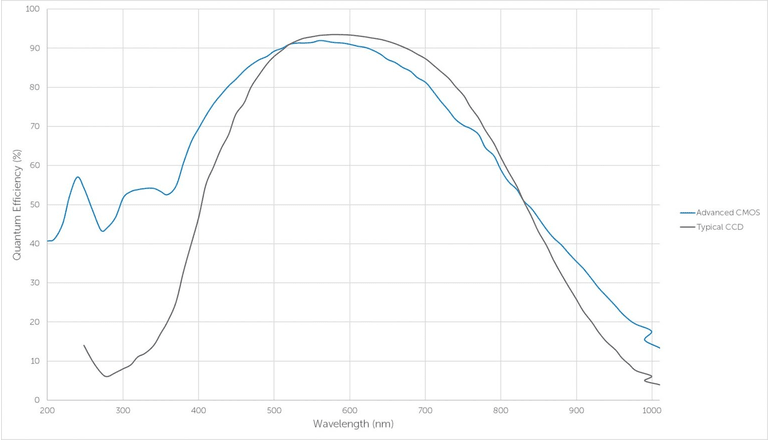
Figure 3: Quantum efficiency curve of an advanced CMOS sensor and a typical back-illuminated CCD sensor.
CMOS Sensor Architecture
Unlike CCD sensors, the c harge to voltage conversion on CMOS sensors takes place in every pixel individually (see Figure 4), with the readout nodes on every column of the sensor operating simultaneously . This parallel readout architecture provides a tremendous speed advantage , allowing CMOS sensors to process acquired data at a much faster rate while achieving lower read noise than CCDs , and without the excess noise of EMCCDs .
Fast readout is not only important for dynamic astronomical imaging , but also for quick decision making and analysis such as in adaptive optics systems for correction of atmospheric turbulence . CMOS sensors also use precise electronic shutters allowing for continuous imaging without loss of data.
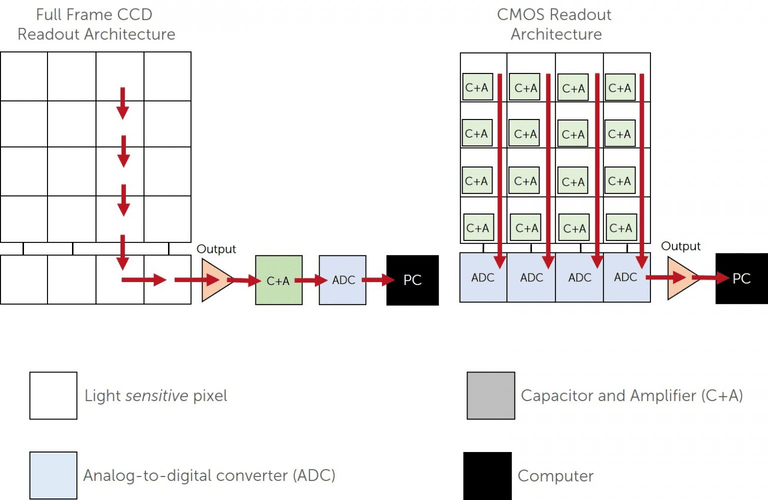
Figure 4: Schematic showing a full frame CCD readout architecture in comparison to a CMOS readout architecture.
Pixels on the full frame CCD are shifted vertically down the sensor until they read the readout array. They
then shift horizontally, pixel-by-pixel, until they are read out by an Analog-to-Digital Converter (ADC). In
comparison, CMOS architecture has an individual ADC per column, increasing the speed of readout
while maintaining a low read noise.
High Dynamic Range
Within astronomy, it is not uncommon to have both bright and faint objects within the same field of view. High dynamic range (HDR) makes the detection of faint astronomical objects possible without saturating the detector with light from surrounding brighter objects. HDR operation depends on linearity, ADC bit-depth and gain . CMOS cameras can extend dynamic range through multiple sampling of the signal with high and low gain. However, artifacts in the cross-over between high and low gain readouts can limit measurement precision.
Advanced CMOS designs, such as Teledyne Imaging LACera™ technology, ensure precise cross-over between both ADCs for operation with low noise and high linearity . Combined with higher bit-depth ADCs , LACeraTM technology provides unsurpassed dynamic range. More details about HDR operation of LACeraTM technology can be found in our article New Era in High Dynamic Range CMOS [6].
True Global Shutter
CMOS sensors typically begin exposure, read out and clear the sensor row-by-row, via a process called a rolling shutter . Although this process is very fast , it can introduce distortions to fast-moving objects, potential delays between frames, and difficulties with synchronization which would be detrimental for many astronomy applications (see Figure 5).
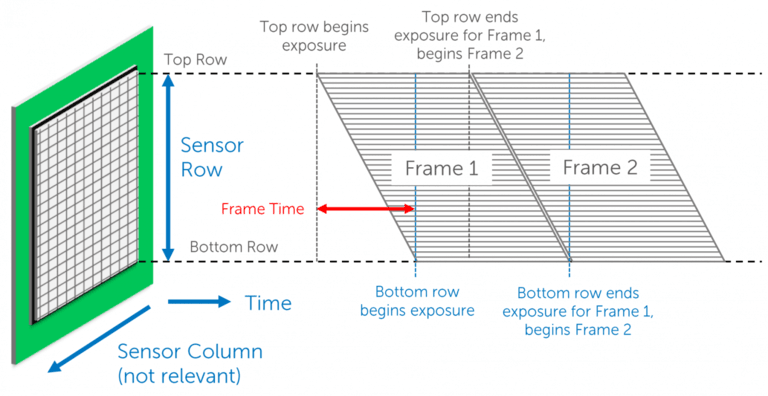
Figure 5: The camera sensor is shown on the left, with rolling shutter architecture meaning that exposure does not begin for the
entire sensor at the same time, but exposure and readout move from the top to the bottom of the sensor. The time dimension
is shown from left to right, with which rows are reading out indicated on the vertical axis. The timescale of the rolling
behaviour is the camera's Frame Time, typically around 20ms.
Alternatively, global shutter , which reads and resets all detector pixels simultaneously , is challenging to engineer for back-illuminated CMOS sensors. For global shutter devices, to end an exposure, photoelectrons need to be moved immediately into a storage area . This storage area is typically light-sensitive , meaning that artifacts can arise from unwanted photons interacting with it.
The storage area can be hidden under sensor components for front-illuminated CMOS sensors ; however, this is more challenging with back-illuminated technology. Advanced back-illuminated CMOS technology, like that of LACera technology, redesigns the storage area to achieve true global shutter operation without artifacts . Find out more about this process in our article: Achieving a True Global Shutter with Large Format, Back-Illuminated CMOS [7].
Large Field of View
Parallelization and high-speed operation make CMOS designs ideal for large area sensor designs . CMOS cameras have now been developed with pixel counts of 6k x 6k and above , alongside large pixel sizes (10 μm) featuring high QE and low read noise required for precise imaging of fainter, high speed objects , or multiple fainter objects within one frame.
Benefits of large sensor sizes include fewer telescope movements for tracking rapidly moving objects (space debris), observing more objects per frame (sky surveys) and better image calibration by observing more reference stars.
Summary
Although CCD and EMCCD technologies have their advantages within ground based astronomical imaging, back-illuminated CMOS camera technology matches their specifications while overcoming their limitations on speed, duty cycle and noise performance.
CMOS designs feature a combination of high QE, high dynamic range, short readout times and low noise making them a competitive alternative for a wide range of astronomy applications. If you would like to find out more about our future CMOS capabilities within astronomy , sign up to our webinar Enabling the Next Generation of Astronomy.
References
[1] Signal, Noise and Detection, O.Hainaut, 2005-Jun-01, URL: http://www.sc.eso.org/~ohainaut/ccd/sn.html
[2] Dark Current, Teledyne Photometrics, accessed 11/01/2021 https://www.photometrics.com/learn/imaging-topics/dark-current
[3] Readout vs. Frame Rate, Teledyne Photometrics, accessed 11/01/2021 https://www.photometrics.com/learn/imaging-topics/readout-vs-frame-rate
[4] G. Kasprowicz et al., CCD detectors for wide field optical astronomy, Photonics Letters of Poland, 1 (2), 2009
[5] Types of Camera Sensor, Teledyne Photometrics, accessed 11/01/2021 https://www.photometrics.com/learn/white-papers/types-of-camera-sensor
[6] New Era in Dynamic Range and Linearity for Scientific CMOS Cameras, Teledyne Princeton Instruments, https://www.princetoninstruments.com/products/technologies-family/lacera/tech-notes/new-era-in-dynamic-range-and-linearity-for-scientific-cmos
[7] Achieving a true global shutter with large format, back-illuminated CMOS, Teledyne Princeton Instruments, https://www.princetoninstruments.com/products/technologies-family/lacera/tech-notes/achieving-a-true-global-shutter-with-large-format-back-illuminated-cmos


